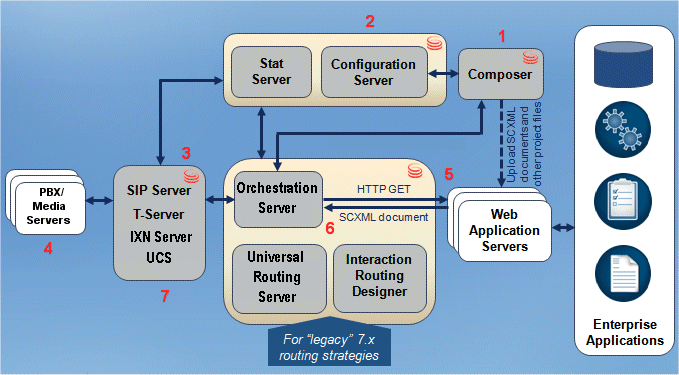Architecture Diagram for Workflows
To give the "Big Picture" and show the various Genesys components used for SCXML-based workflows, below is a high-level diagram of the Universal Routing 8.x architecture.
The SCXML-based strategy creation and processing steps above are keyed to the numbers below.
- The developer (or other persona) creates and tests the workflow application and manually deploys it on a Web application server.
- For Web application server requirements related to Composer, see the Composer 8.1 Deployment Guide.
- For developing SCXML applications and related resources that will be executed on the Genesys Universal Routing Server/ Orchestration Server platform, only specific Web application servers are supported. Refer to the Orchestration Server 8.1 Deployment Guide for more information.
The developer specifies Configuration Server objects as routing targets when creating the workflow application in Composer. For example, a routing target could be an agent (Person object) or Agent Group or an interaction can be sent to a queue. The developer may also create workflows that route based on the value of a Stat Server statistic or a statistic that you defined in Composer's Statistics Builder.
- The developer or other persona configures:
- Universal Routing Server (URS) and the Routing Point as described in the Universal Routing 8.1 Deployment Guide.
- Orchestration Server as described in the Orchestration Server 8.1 Deployment Guide.
Once this is done, the runtime life cycle of the routing logic can begin with a routing request.
- URS gets an EventRouteRequest message from T-Server or another media server.
- The request goes to the Routing Point. URS gets the URL of the Application Server to be contacted about SCXML strategy to be provided, which is a property of the Routing Point. After the URL is obtained, ORS issues the HTTP GET ( or POST) request to the application server.
- The application server executes the request and returns the SCXML document back to ORS.
- Upon getting the response, ORS passes the received SCXML document to the SCXML engine. The SCXML engine runs the SCXML application, invoking ORS/URS services as needed.
- ORS or URS issues a RequestRouteCall message to the media server.

